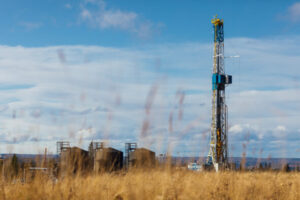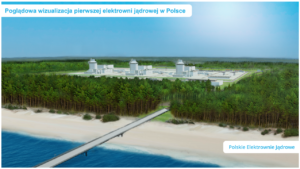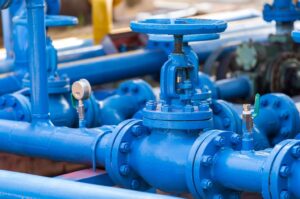For almost a month the Fortuna barge has been continuing the construction of the Nord Stream 2 gas pipeline. So far, apart from a few problems caused by storms over the Baltic, the pipe laying is going without interruptions. Will the Akademik Cherskiy join in soon? – Mariusz Marszałkowski, editor at BiznesAlert.pl, writes.
How much has been achieved after a month of building NS2?
On the sixth of March a month will have passed since the Fortuna barge started preparations to lay pipes of the NS2 gas pipeline in the Danish exclusive economic zone (EEZ). However, due to a heavy storm the actual work began on the 16th of February. Since then, the Fortuna has laid about 10 km of one line of the gas pipeline. When the weather is good, the pace of the work is faster than initially expected. The average speed of pipe laying between 16 of February and 1 March was over 670 meters per day. However, in the last few days it went up to almost a kilometer per day.
Currently the work takes place at a depth between 50 and 64 meters. The closer to the border with the German EEZ, the shallower the depth of the works will get. This may mean that soon the Fortuna will pick up the pace and exceed a kilometer a day. Without a doubt this will be a success for Russians, because at first it was estimated that the ship would only be able to lay 400-500 meters of pipes per day.
Despite the fact that Russians had no previous experience in underwater projects of a scale similar to the challenge posed by NS2, so far the entire process looks well-organized. Apart from the Fortuna, three anchor handling tug vessels also work interchangeably at the construction site (Katun, Umka, Finval, Errie). Three supply ships are also assigned to the works (interchangeably Artemis Offshore, Ivan Sidorenko, Ostap Sheremeta, Yury Topchev, Venie), as well as two exploration vessels (Baltiyskiy Issledovatel, Murman). So far no incidents have impacted the pace of the work. Temporary slow-downs are usually caused by the weather conditions on the Baltic Sea.
As at the 1st of March, the following number of km need to completed: 40 km in the Danish and 17 in the German zone of line A, and 67 km in the Danish and 5 km in the German zone of line B.
The Baltic triangle
The fleet that has been mobilized to finish the construction is so big that not all of the ships take part in the works at a given moment.
Some move regularly between the ports Kaliningrad – Murkan – Wismar. At this point those three towns are involved with the NS2 the most.
The port in Kaliningrad is used by the supply vessels as their base, and it is also the project’s service and logistic center. The equipment ordered by Gazprom’s HQ in Petersburg to complete the gas pipeline is distributed from that location. From there everything is transported by sea to the ships that lay down the pipes. The transport is usually provided by Artemis Offshore.
Mukran is the most important harbor for the construction of NS2, as it is the project’s logistic center. The harbor stores the pipes used for the construction of the gas pipeline, as well as the food, water and fuel for the crews, it also provides bunkering for the supply vessels. Vessels that are used to exchange the crews also set out from this port (DP Gezina). When Allseas was responsible for the construction, it used German and Danish companies that chartered helicopters. Presently no helicopters have been seen.
In the port of Wismar, which is a little further from NS2, the pipe laying vessels are prepared to meet the technical demands of constructing the pipeline. Between August and December 2020, the Fortuna barge was upgraded there, and since December the Akademik Cherskiy has been stationed there.
Will the Akademik Cherskiy join the team?
The ship, which has had a long and troubled history related to NS2, has in the past few days reemerged on the radar of those who are following the progress on the NS2 construction site. According to the latest entry in the AIS system for Akademik Cherskiy, the ship will proceed to sea on the 5th of March at 8 a.m. The destination has not been revealed, but considering the recent activities around, among others, the ship’s stinger (ramp used to lower pipes into the sea), it seems it is possible that Cherskiy will join the construction. However, at this point it is difficult to say what will happen exactly. The history of the ship’s voyage from Nakhodka to the Baltic Sea showed one should be skeptical about the entries is Akademik Cherskiy AIS history.
Also, at this point the Danish Maritime Authority (DMA), which issues navigational warnings about traffic in Danish waters, has not reported that the Akademik Cherskiy would take up any construction activities at the site. In the navigational warning repeated on the 7th of February 2021, the DMA talked about the work performed on both strings of the NS2, which is done by the Fortuna barge, together with the research and inspection vessels Murman and Baltiyskiy Issledovatel and other supply ships. The warning does not mention the Akademik Cherskiy.
This means there are three possibilities:
In the first one, the Akademik Cherskiy would work in the German section (to complete the missing 30 km of both strings). However, for it to happen the German Federal Maritime and Hydrographic Agency (BSH) would have to issue a construction permit that would be binding during the protection period for resting seabirds. Gazprom applied for such a permit in early February (BSH’s earlier decision to allow the construction during the protection period was challenged in court by environmental organizations in Germany). If such a permit is not given, the earliest the works in Germany’s EEZ will be able to start is 15th May. However, considering the fact that BSH’s previous decisions were very favorable to NS2 (e.g. conditional permit for construction in the protection period issued in December 2019), it can be expected that the probability of a positive decision is very high.
The second possibility is that the Akademik Cherskiy would join the Fortuna in laying the pipes in the Danish EEZ. For this to happen, the company Nord Stream 2 AG would have to apply to the DMA. This is an administrative procedure, which the Danes cannot obstruct. In theory such a solution would make it possible to finish the pipe within the deadline assumed by Gazprom, i.e. by the end of April 2021. Despite its efficiency, the Fortuna would not be able to complete the task before this date. In this scenario there are two options. In the first one, the ship will complete string A of the pipe and then continue work to meet the Fortuna, which would come from the other direction. In the second version, the vessel would start works on the longer, unfinished section of the gas pipeline – the B string, and would lay pipes in parallel to the Fortuna in the direction of the border between the German and Danish EEZ.
The third option is that the Akademik Cherskiy would start another phase of tests and underwater trials. There is no information on whether the ship is ready to participate in the construction, and whether it has all the necessary certificates to operate in the German or Danish EEZ. It is possible that the vessel is still being upgraded in the port of Wismar. Interestingly, the Akademik Cherskiy’s draught is now deeper, but this may or may not be related to the Nord Stream 2. During the voyage from Nakhodka to the Baltic the draught was not more than 6.5 meters. Currently, according to navigational data, the ship’s draught is 7.3 meters. This means it carries a lot of weight.
Will the saga be over once the pipe is completed?
Despite its technical limitations the Fortuna barge turned out an efficient vessel for the completion of the NS2. Even the U.S. sanctions imposed on it and its „owner” cannot stop the works. The entire construction process – from transporting pipes and equipment, replacing the crew to research and inspections – looks very professional. Without a doubt, despite the obvious increase in investment cost, the completion of the Nord Stream 2 gas pipeline may be Russia’s opportunity to build its own know-how in the area of the construction of underwater gas pipelines. It is difficult to tell whether and to what degree it will be used, but there is no question that this experience may be used in Gazprom’s future projects. However, the physical completion of the pipe does not mean it will be operational. Everything depends on whether the sanctions, which threaten western companies responsible for, e.g. certification of the project, will be rigidly enforced by Americans, and whether alternatives from Russia will be accepted by, among others, Denmark.









